初中英语语法八大时态知识总结附学习方法
初中英语语法动词八种时态详解
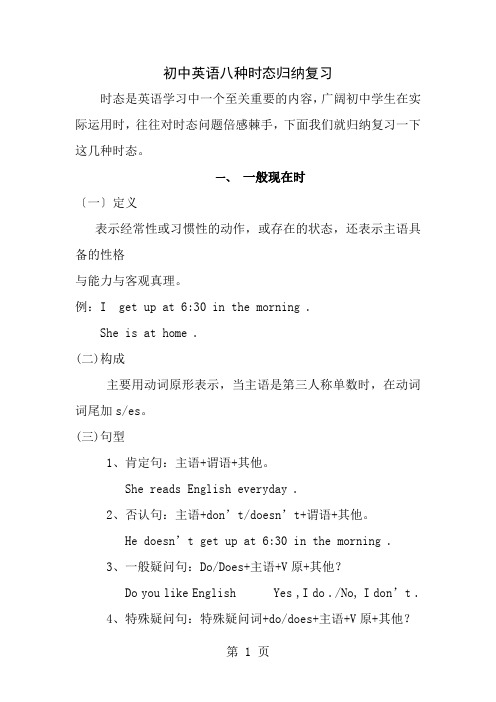
初中英语八种时态归纳复习时态是英语学习中一个至关重要的内容,广阔初中学生在实际运用时,往往对时态问题倍感棘手,下面我们就归纳复习一下这几种时态。
一、一般现在时〔一〕定义表示经常性或习惯性的动作,或存在的状态,还表示主语具备的性格与能力与客观真理。
例:I get up at 6:30 in the morning .She is at home .(二)构成主要用动词原形表示,当主语是第三人称单数时,在动词词尾加s/es。
(三)句型1、肯定句:主语+谓语+其他。
She reads English everyday .2、否认句:主语+don’t/doesn’t+谓语+其他。
He doesn’t get up at 6:30 in the morning .3、一般疑问句:Do/Does+主语+V原+其他?Do you like English Yes ,I do ./No, I don’t .4、特殊疑问句:特殊疑问词+do/does+主语+V原+其他?What time do you get up every morningWhere does your father work〔三〕用法1、表示经常性或习惯性的动作,或存在的状态,带与表示频率的时间状语如:often , sometimes , usually,always , everyday year,month...〕 , once/twice a week (month , year , etc.) , seldom , on sundays等连用。
I leave home for school at seven every morning .2、表示客观真理,科学事实、格言警句。
The sun rises in the east .日出东方。
The earth goes around the sun .地球绕着太阳转。
Ten minus two is eight.十减二等于八。
初中英语八大时态知识点详解 4
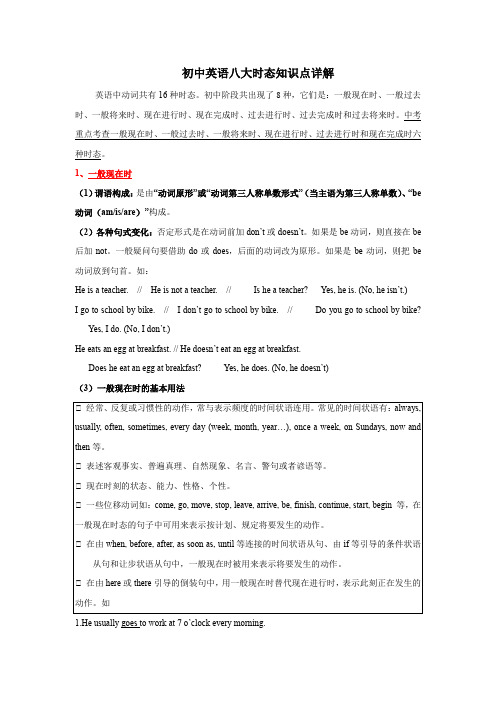
初中英语八大时态知识点详解英语中动词共有16种时态。
初中阶段共出现了8种,它们是:一般现在时、一般过去时、一般将来时、现在进行时、现在完成时、过去进行时、过去完成时和过去将来时。
中考重点考查一般现在时、一般过去时、一般将来时、现在进行时、过去进行时和现在完成时六种时态。
1、一般现在时(1)谓语构成:是由“动词原形”或“动词第三人称单数形式”(当主语为第三人称单数)、“be 动词(am/is/are)”构成。
(2)各种句式变化:否定形式是在动词前加don’t或doesn’t。
如果是be动词,则直接在be 后加not。
一般疑问句要借助do或does,后面的动词改为原形。
如果是be动词,则把be 动词放到句首。
如:He is a teacher. // He is not a teacher. // ---- Is he a teacher? --- Yes, he is. (No, he isn’t.)I go to school by bike. // I don’t go to school by bike. // ---- Do you go to school by bike? ---- Yes, I do. (No, I don’t.)He eats an egg at breakfast. // He doesn’t eat an egg at breakfast.---- Does he eat an egg at breakfast? ---- Yes, he does. (No, he doesn’t)(3)一般现在时的基本用法1.He usually goes to work at 7 o’clock every morning.2.Every dog has its day. 凡人皆有得意日。
3.Pride goes before a fall. 骄者必败。
4.The earth goes around the sun. 地球绕着太阳转。
初中英语八大时态归纳总结
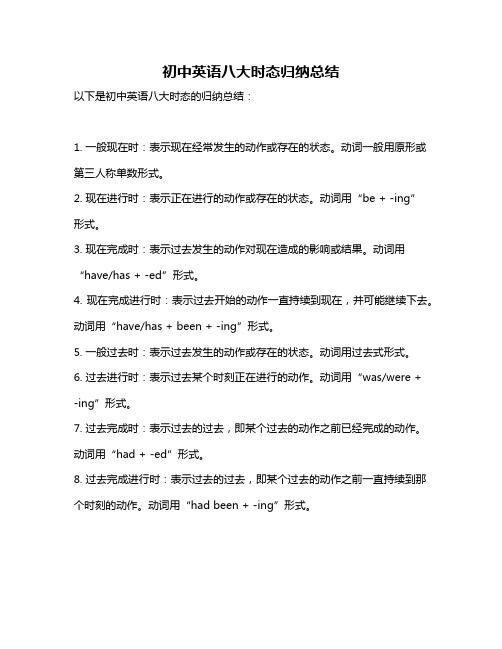
初中英语八大时态归纳总结
以下是初中英语八大时态的归纳总结:
1. 一般现在时:表示现在经常发生的动作或存在的状态。
动词一般用原形或第三人称单数形式。
2. 现在进行时:表示正在进行的动作或存在的状态。
动词用“be + -ing”
形式。
3. 现在完成时:表示过去发生的动作对现在造成的影响或结果。
动词用“have/has + -ed”形式。
4. 现在完成进行时:表示过去开始的动作一直持续到现在,并可能继续下去。
动词用“have/has + been + -ing”形式。
5. 一般过去时:表示过去发生的动作或存在的状态。
动词用过去式形式。
6. 过去进行时:表示过去某个时刻正在进行的动作。
动词用“was/were + -ing”形式。
7. 过去完成时:表示过去的过去,即某个过去的动作之前已经完成的动作。
动词用“had + -ed”形式。
8. 过去完成进行时:表示过去的过去,即某个过去的动作之前一直持续到那个时刻的动作。
动词用“had been + -ing”形式。
以上是初中英语的八大时态,理解和掌握这些时态对于英语学习和交流非常重要。
初中英语8个时态归纳总结
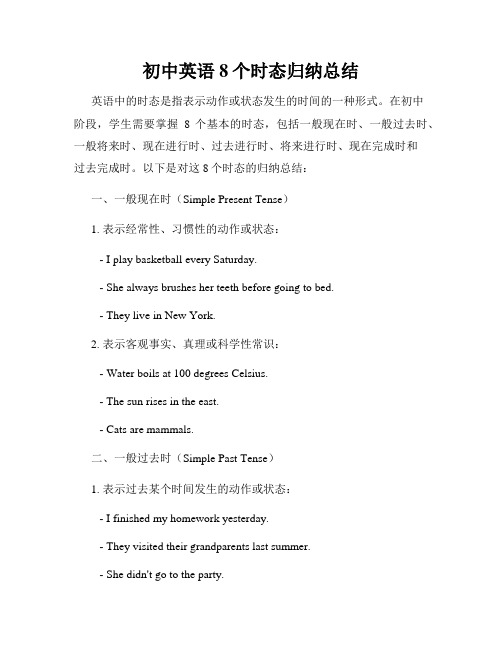
初中英语8个时态归纳总结英语中的时态是指表示动作或状态发生的时间的一种形式。
在初中阶段,学生需要掌握8个基本的时态,包括一般现在时、一般过去时、一般将来时、现在进行时、过去进行时、将来进行时、现在完成时和过去完成时。
以下是对这8个时态的归纳总结:一、一般现在时(Simple Present Tense)1. 表示经常性、习惯性的动作或状态:- I play basketball every Saturday.- She always brushes her teeth before going to bed.- They live in New York.2. 表示客观事实、真理或科学性常识:- Water boils at 100 degrees Celsius.- The sun rises in the east.- Cats are mammals.二、一般过去时(Simple Past Tense)1. 表示过去某个时间发生的动作或状态:- I finished my homework yesterday.- They visited their grandparents last summer.- She didn't go to the party.2. 表示过去的经历或习惯:- When I was young, I often went swimming. - He always ate breakfast at 8 o'clock.三、一般将来时(Simple Future Tense)1. 表示将来要发生的动作或事件:- I will go shopping tomorrow.- They are going to have a picnic next week. - She won't be late for the meeting.2. 表示将来的打算或意愿:- I am going to be a doctor when I grow up.- We will help you with your project.四、现在进行时(Present Continuous Tense)1. 表示现在正在进行的动作:- We are studying English at the moment.- He is playing soccer with his friends.- They aren't watching TV right now.2. 表示现阶段的趋势或变化:- The population is increasing rapidly.- More and more people are using smartphones.五、过去进行时(Past Continuous Tense)1. 表示过去某一时间段内正在进行的动作:- I was reading a book when the phone rang.- They were cooking dinner at 7 o'clock.2. 表示过去的同时发生的两个动作:- She was listening to music while doing her homework.六、将来进行时(Future Continuous Tense)1. 表示将来某一时间段内正在进行的动作:- Tomorrow, they will be flying to Paris.- I will be waiting for you at the station.2. 表示将来的预测或计划:- This time next month, I will be studying for my exams.七、现在完成时(Present Perfect Tense)1. 表示过去某一时间发生的动作对现在造成的影响或结果: - I have finished my homework, so I can watch TV now.- She has already eaten lunch.2. 表示过去某一时间内多次发生的动作:- We have visited that museum several times.八、过去完成时(Past Perfect Tense)1. 表示过去某一时间点之前已经完成的动作:- By the time they arrived, we had already left.- I had finished my work before the deadline.2. 表示过去的顺序或先后关系:- She realized that she had forgotten her keys after she locked the door.以上是初中英语的8个时态的归纳总结。
初中英语必考的“八大时态”用法总结

初中英语必考的“八大时态”用法总结“时态”无疑是学习英语时最重要的语法内容,学好时态基本就拿下了语法的半壁江山。
今天总结了初中英语必考的“八种时态”必学、必考,一定要加倍重视!英语八大时态一、一般现在时do/does;is/am/are①表示现在的情况、状态或特征。
例:He is a student.他是一个学生。
②表示经常性、习惯性动作。
例:He always helps others.他总是帮助别人。
③客观事实和普遍真理。
例:The earth moves the sun.地球绕着太阳转。
④表示一个按规定、计划或安排要发生的动作。
仅限于某些表示“来、去、动、停、开始、结束、继续”等的动词,可以与表示未来时间的状语搭配使用。
常见的用法是:飞机、火车、轮船、汽车等定期定点运行的交通方式。
例:The next train leaves at 3 o'clock this afternoon.下一趟火车今天下午3点开车。
⑤在时间、条件和让步状语从句中经常用一般现在(有时也用现在完成时)表示将来事情。
(即:主将从现原则)例:I will call you as soon as I arrive at the airport.我一到机场就会给你打电话。
When you have finished the report,I will have waited for about 3 hours.等你完成这份报告的时候,我就已经等了将近3个小时了。
一般过去时①表示过去某个时间发生的动作或情况。
例:I bought some fruits yesterday.我昨天买了一些水果。
②表示过去习惯性动作。
例:When I was a boy,I often swamin that river.would/used to do:表示过去常常......例:The old man would sit on a bench in the quiet park and look at others for hours without doing anything or talking to anybody.老人过去常常坐在宁静的公园里的一条长椅上,看着其他的人,一坐就是数个小时,什么也不干,也不和任何人交谈。
初中英语八大时态总结
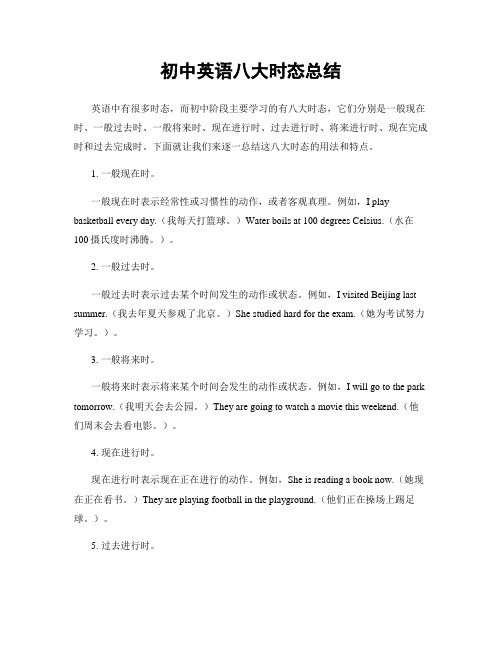
初中英语八大时态总结英语中有很多时态,而初中阶段主要学习的有八大时态,它们分别是一般现在时、一般过去时、一般将来时、现在进行时、过去进行时、将来进行时、现在完成时和过去完成时。
下面就让我们来逐一总结这八大时态的用法和特点。
1. 一般现在时。
一般现在时表示经常性或习惯性的动作,或者客观真理。
例如,I play basketball every day.(我每天打篮球。
)Water boils at 100 degrees Celsius.(水在100摄氏度时沸腾。
)。
2. 一般过去时。
一般过去时表示过去某个时间发生的动作或状态。
例如,I visited Beijing last summer.(我去年夏天参观了北京。
)She studied hard for the exam.(她为考试努力学习。
)。
3. 一般将来时。
一般将来时表示将来某个时间会发生的动作或状态。
例如,I will go to the park tomorrow.(我明天会去公园。
)They are going to watch a movie this weekend.(他们周末会去看电影。
)。
4. 现在进行时。
现在进行时表示现在正在进行的动作。
例如,She is reading a book now.(她现在正在看书。
)They are playing football in the playground.(他们正在操场上踢足球。
)。
5. 过去进行时。
过去进行时表示过去某个时间正在进行的动作。
例如,I was studying when she called me.(她给我打电话的时候,我正在学习。
)They were playing games at that time.(他们那时在玩游戏。
)。
6. 将来进行时。
将来进行时表示将来某个时间正在进行的动作。
例如,I will be having dinner at 7 o'clock tonight.(我今晚7点会在吃晚饭。
(完整版)初中英语语法时态讲解与归纳

(完整版)初中英语语法时态讲解与归纳初中英语语法时态讲解与归纳一、时态的分类英语中的时态包括一般现在时、一般过去时、一般将来时、现在进行时、过去进行时、将来进行时、现在完成时、过去完成时和将来完成时等。
下面将分别进行介绍和归纳。
二、一般现在时一般现在时用于表示经常性的动作、惯、真理等。
其基本结构为:主语 + 动词原形。
例句:- I play football every Sunday.(我每个星期天踢足球。
)- He doesn't like coffee.(他不喜欢咖啡。
)- Does she speak English?(她会说英语吗?)三、一般过去时一般过去时用于表示过去发生的动作或状态。
其基本结构为:主语 + 动词过去式。
例句:- I went to the park yesterday.(我昨天去了公园。
)- They played basketball last night.(他们昨晚打篮球。
)- Did you finish your homework?(你完成作业了吗?)四、一般将来时一般将来时用于表示将来发生的动作或状态。
其基本结构为:主语 + will + 动词原形。
例句:- I will call you later.(我稍后会给你打电话。
)- She will visit her grandparents next week.(她下周会去看望她的祖父母。
)五、现在进行时现在进行时用于表示现在进行的动作。
其基本结构为:主语 + am/is/are + 动词-ing 形式。
例句:- He is studying in the library now.(他现在正在图书馆研究。
)- They are playing soccer in the park.(他们正在公园里踢足球。
)- Is she watching TV at the moment?(她现在正在看电视吗?)六、过去进行时过去进行时用于表示过去某个时间点正在进行的动作。
学习笔记——英语语法的八大时态
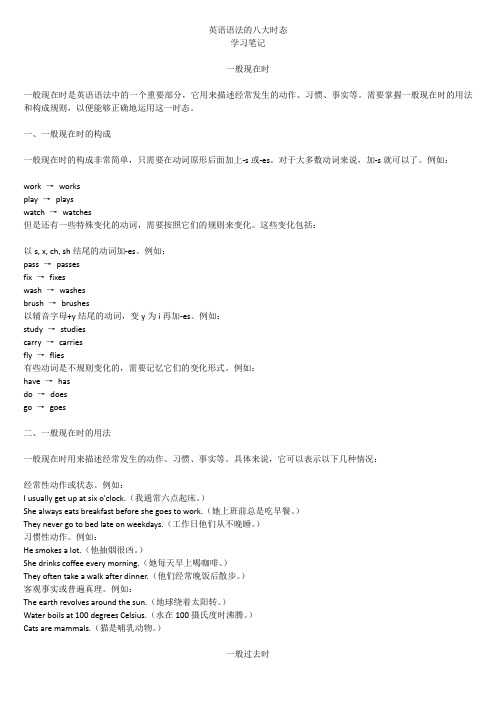
英语语法的八大时态学习笔记一般现在时一般现在时是英语语法中的一个重要部分,它用来描述经常发生的动作、习惯、事实等。
需要掌握一般现在时的用法和构成规则,以便能够正确地运用这一时态。
一、一般现在时的构成一般现在时的构成非常简单,只需要在动词原形后面加上-s或-es。
对于大多数动词来说,加-s就可以了。
例如:work →worksplay →playswatch →watches但是还有一些特殊变化的动词,需要按照它们的规则来变化。
这些变化包括:以s, x, ch, sh结尾的动词加-es。
例如:pass →passesfix →fixeswash →washesbrush →brushes以辅音字母+y结尾的动词,变y为i再加-es。
例如:study →studiescarry →carriesfly →flies有些动词是不规则变化的,需要记忆它们的变化形式。
例如:have →hasdo →doesgo →goes二、一般现在时的用法一般现在时用来描述经常发生的动作、习惯、事实等。
具体来说,它可以表示以下几种情况:经常性动作或状态。
例如:I usually get up at six o'clock.(我通常六点起床。
)She always eats breakfast before she goes to work.(她上班前总是吃早餐。
)They never go to bed late on weekdays.(工作日他们从不晚睡。
)习惯性动作。
例如:He smokes a lot.(他抽烟很凶。
)She drinks coffee every morning.(她每天早上喝咖啡。
)They often take a walk after dinner.(他们经常晚饭后散步。
)客观事实或普遍真理。
例如:The earth revolves around the sun.(地球绕着太阳转。
初中英语语法八大时态总结完整版
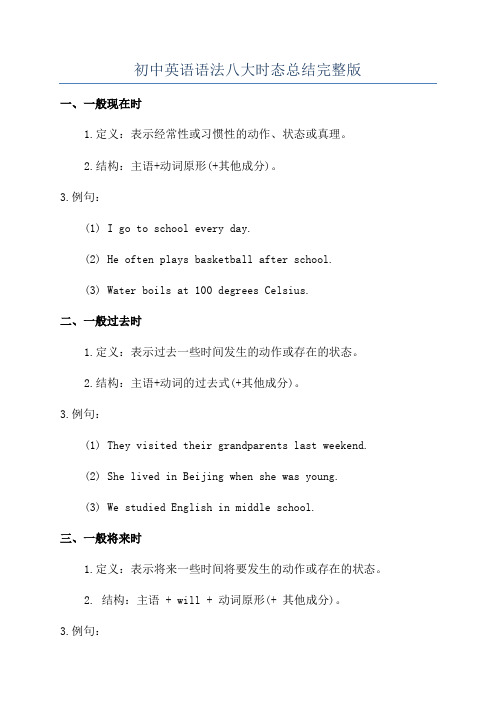
初中英语语法八大时态总结完整版一、一般现在时1.定义:表示经常性或习惯性的动作、状态或真理。
2.结构:主语+动词原形(+其他成分)。
3.例句:(1) I go to school every day.(2) He often plays basketball after school.(3) Water boils at 100 degrees Celsius.二、一般过去时1.定义:表示过去一些时间发生的动作或存在的状态。
2.结构:主语+动词的过去式(+其他成分)。
3.例句:(1) They visited their grandparents last weekend.(2) She lived in Beijing when she was young.(3) We studied English in middle school.三、一般将来时1.定义:表示将来一些时间将要发生的动作或存在的状态。
2. 结构:主语 + will + 动词原形(+ 其他成分)。
3.例句:(1) I will go to the park tomorrow.(3) We will have a party next week.四、现在进行时1.定义:表示现在正在进行的动作。
2. 结构:主语 + am/is/are + 动词-ing(+ 其他成分)。
3.例句:(1) She is reading a book right now.(2) They are playing soccer in the park.(3) We are having dinner at the moment.五、过去进行时1.定义:表示过去一些时间正在进行的动作。
2. 结构:主语 + was/were + 动词-ing(+ 其他成分)。
3.例句:(1) He was watching TV at 8 o'clock last night.(2) They were traveling in Europe during summer vacation.(3) We were studying when the phone rang.六、将来进行时1.定义:表示将来一些时间正在进行的动作。
初中英语语法八大时态总结(完整版)
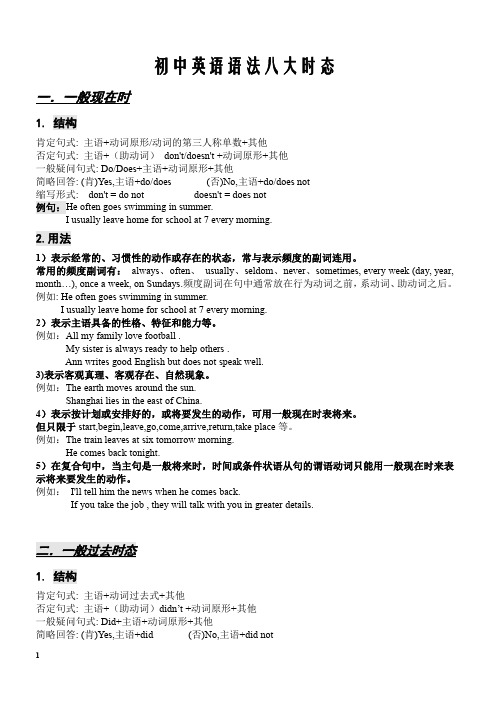
初中英语语法八大时态一.一般现在时1.结构肯定句式:主语+动词原形/动词的第三人称单数+其他否定句式:主语+(助动词)don't/doesn't+动词原形+其他一般疑问句式:Do/Does+主语+动词原形+其他简略回答:(肯)Yes,主语+do/does(否)No,主语+do/does not缩写形式:don't=do not doesn't=does not例句:He often goes swimming in summer.I usually leave home for school at7every morning.2.用法1)表示经常的、习惯性的动作或存在的状态,常与表示频度的副词连用。
常用的频度副词有:always、often、usually、seldom、never、sometimes,every week(day,year, month…),once a week,on Sundays.频度副词在句中通常放在行为动词之前,系动词、助动词之后。
例如:He often goes swimming in summer.I usually leave home for school at7every morning.2)表示主语具备的性格、特征和能力等。
例如:All my family love football.My sister is always ready to help others.Ann writes good English but does not speak well.3)表示客观真理、客观存在、自然现象。
例如:The earth moves around the sun.Shanghai lies in the east of China.4)表示按计划或安排好的,或将要发生的动作,可用一般现在时表将来。
但只限于start,begin,leave,go,come,arrive,return,take place等。
初中英语八大时态的详细讲解与练习
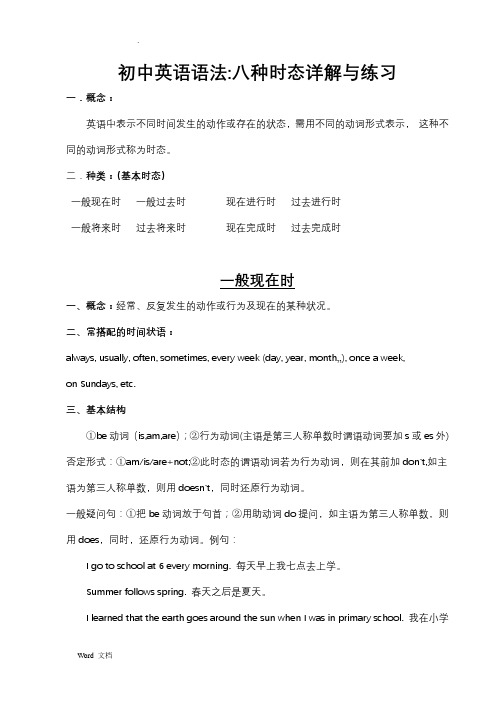
初中英语语法:八种时态详解与练习一.概念:英语中表示不同时间发生的动作或存在的状态,需用不同的动词形式表示,这种不同的动词形式称为时态。
二.种类:(基本时态)一般现在时一般过去时现在进行时过去进行时一般将来时过去将来时现在完成时过去完成时一般现在时一、概念:经常、反复发生的动作或行为及现在的某种状况。
二、常搭配的时间状语:always, usually, often, sometimes, every week (day, year, month…), once a week,on Sundays, etc.三、基本结构①be动词(is,am,are);②行为动词(主语是第三人称单数时谓语动词要加s或es外) 否定形式:①am/is/are+not;②此时态的谓语动词若为行为动词,则在其前加don't,如主语为第三人称单数,则用doesn't,同时还原行为动词。
一般疑问句:①把be动词放于句首;②用助动词do提问,如主语为第三人称单数,则用does,同时,还原行为动词。
例句:I go to school at 6 every morning. 每天早上我七点去上学。
Summer follows spring. 春天之后是夏天。
I learned that the earth goes around the sun when I was in primary school. 我在小学就学过地球是围绕太阳转的。
Pride goes before a fall. 骄者必败。
四、基本用法:1) 描述当前时间经常出现、反复发生的动作或存在的状态。
在这种情景中,句子常带有表示频率的时间状语:always , everyday , often , once a week (month , year , etc.) , sometimes , seldom , usually等等,以表示句中的动作或状态是习惯性的、经常性的。
初中英语语法八大时态总结
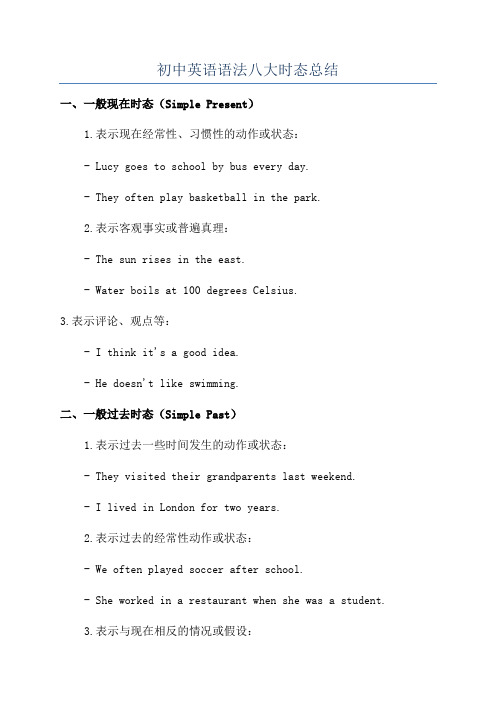
初中英语语法八大时态总结一、一般现在时态(Simple Present)1.表示现在经常性、习惯性的动作或状态:- Lucy goes to school by bus every day.- They often play basketball in the park.2.表示客观事实或普遍真理:- The sun rises in the east.- Water boils at 100 degrees Celsius.3.表示评论、观点等:- I think it's a good idea.- He doesn't like swimming.二、一般过去时态(Simple Past)1.表示过去一些时间发生的动作或状态:- They visited their grandparents last weekend.- I lived in London for two years.2.表示过去的经常性动作或状态:- We often played soccer after school.- She worked in a restaurant when she was a student.3.表示与现在相反的情况或假设:- If I had money, I would buy a new car.- I wish I could go to the concert with you.三、一般将来时态(Simple Future)1.表示将来要发生的事情:- I will meet him at the airport tomorrow.- They are going to have a party next week.2.表示意愿、打算或承诺:- I promise I will help you.- She is going to study abroad next year.四、现在进行时态(Present Continuous)1.表示现在正在进行或暂时的动作:- They are playing football in the park.- He is studying for the exam.2.表示现阶段的变化或趋势:- The population of the city is increasing rapidly.- More and more people are using smartphones.五、过去进行时态(Past Continuous)1.表示过去一些时间正在进行中的动作:- I was watching TV when she called me.- They were having dinner when the power went out.2.表示过去一些时间同时发生的两个动作:- While he was reading, his sister was playing the piano.- When I arrived, they were still waiting for you.六、将来进行时态(Future Continuous)1.表示将来一些时间正在进行的动作:- He will be sleeping when you arrive.2.表示将来一些时间同时发生的两个动作:- While you are washing the dishes, I will be cleaning the bathroom.- When I call you, she will be cooking dinner.七、现在完成时态(Present Perfect)1.表示过去发生但对现在有影响的动作或状态:- I have lost my key, so I can't open the door.- She has finished her homework, so she can watch TV now.2.表示经历或遭遇过的事情:- Have you ever been to Paris?- He has never seen such a beautiful sunset.八、过去完成时态(Past Perfect)1.表示在过去一些时间之前已经发生的动作或状态:- When I arrived, they had already left.2.表示过去一些时间之前一直存在或保持的状态:- He had lived in that house for 10 years before he moved out.- She had been planning the party for weeks.。
最新初中英语语法-八种时态详解与练习
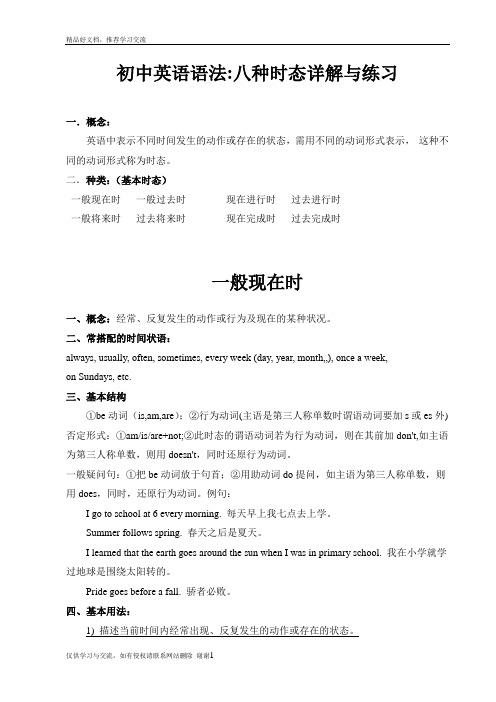
初中英语语法:八种时态详解与练习一.概念:英语中表示不同时间发生的动作或存在的状态,需用不同的动词形式表示,这种不同的动词形式称为时态。
二.种类:(基本时态)一般现在时一般过去时现在进行时过去进行时一般将来时过去将来时现在完成时过去完成时一般现在时一、概念:经常、反复发生的动作或行为及现在的某种状况。
二、常搭配的时间状语:always, usually, often, sometimes, every week (day, year, month…), once a week,on Sundays, etc.三、基本结构①be动词(is,am,are);②行为动词(主语是第三人称单数时谓语动词要加s或es外) 否定形式:①am/is/are+not;②此时态的谓语动词若为行为动词,则在其前加don't,如主语为第三人称单数,则用doesn't,同时还原行为动词。
一般疑问句:①把be动词放于句首;②用助动词do提问,如主语为第三人称单数,则用does,同时,还原行为动词。
例句:I go to school at 6 every morning. 每天早上我七点去上学。
Summer follows spring. 春天之后是夏天。
I learned that the earth goes around the sun when I was in primary school. 我在小学就学过地球是围绕太阳转的。
Pride goes before a fall. 骄者必败。
四、基本用法:1) 描述当前时间内经常出现、反复发生的动作或存在的状态。
在这种情景中,句子常带有表示频率的时间状语:always , everyday , often , once a week (month , year , etc.) , sometimes , seldom , usually等等,以表示句中的动作或状态是习惯性的、经常性的。
初中英语语法动词八种时态详解
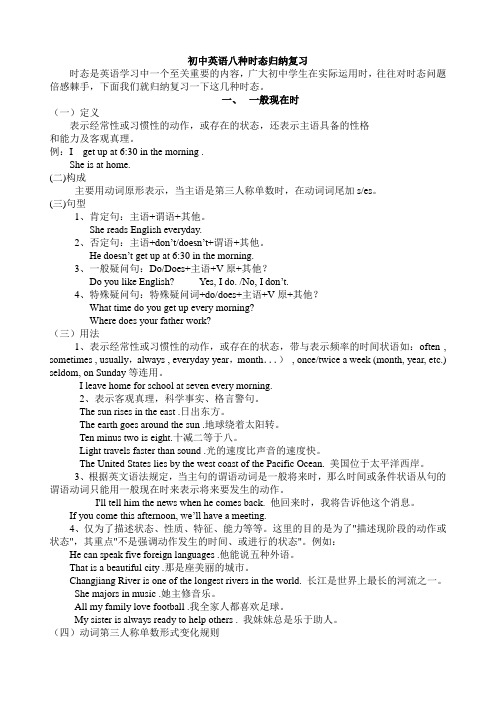
初中英语八种时态归纳复习时态是英语学习中一个至关重要的内容,广大初中学生在实际运用时,往往对时态问题倍感棘手,下面我们就归纳复习一下这几种时态。
一、一般现在时(一)定义表示经常性或习惯性的动作,或存在的状态,还表示主语具备的性格和能力及客观真理。
例:I get up at 6:30 in the morning .She is at home.(二)构成主要用动词原形表示,当主语是第三人称单数时,在动词词尾加s/es。
(三)句型1、肯定句:主语+谓语+其他。
She reads English everyday.2、否定句:主语+don’t/doesn’t+谓语+其他。
He doesn’t get up at 6:30 in the morning.3、一般疑问句:Do/Does+主语+V原+其他?Do you like English? Yes, I do. /No, I don’t.4、特殊疑问句:特殊疑问词+do/does+主语+V原+其他?What time do you get up every morning?Where does your father work?(三)用法1、表示经常性或习惯性的动作,或存在的状态,带与表示频率的时间状语如:often , sometimes , usually,always , everyday year,month...), once/twice a week (month, year, etc.) seldom, on Sunday等连用。
I leave home for school at seven every morning.2、表示客观真理,科学事实、格言警句。
The sun rises in the east .日出东方。
The earth goes around the sun .地球绕着太阳转。
Ten minus two is eight.十减二等于八。
初中英语语法八大时态总结(完整版)
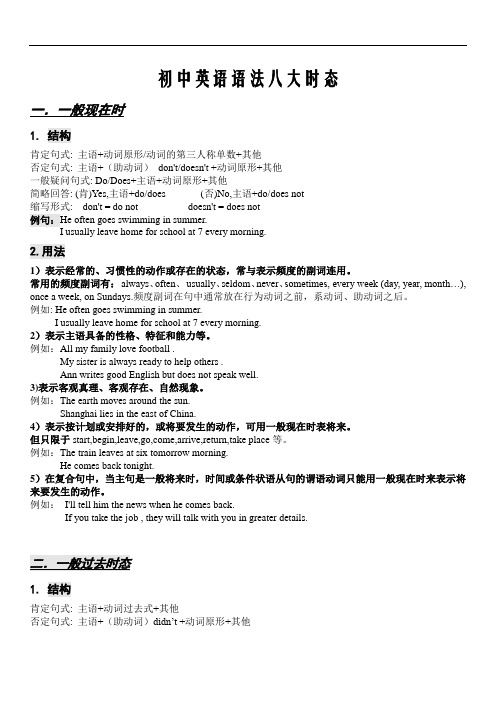
初中英语语法八大时态一.一般现在时1.结构肯定句式: 主语+动词原形/动词的第三人称单数+其他否定句式: 主语+(助动词)don't/doesn't +动词原形+其他一般疑问句式: Do/Does+主语+动词原形+其他简略回答: (肯)Yes,主语+do/does (否)No,主语+do/does not缩写形式: don't = do not doesn't = does not例句:He often goes swimming in summer.I usually leave home for school at 7 every morning.2.用法1)表示经常的、习惯性的动作或存在的状态,常与表示频度的副词连用。
常用的频度副词有:always、often、usually、seldom、never、sometimes, every week (day, year, month…), once a week, on Sundays.频度副词在句中通常放在行为动词之前,系动词、助动词之后。
例如: He often goes swimming in summer.I usually leave home for school at 7 every morning.2)表示主语具备的性格、特征和能力等。
例如:All my family love football .My sister is always ready to help others .Ann writes good English but does not speak well.3)表示客观真理、客观存在、自然现象。
例如:The earth moves around the sun.Shanghai lies in the east of China.4)表示按计划或安排好的,或将要发生的动作,可用一般现在时表将来。
初中英语语法八大时态知识总结及学习策略

初中英语语法八大时态知识总结及学习策略一般现在时1.概念:经常、反复发生的动作或行为及现在的某种状况。
2.基本结构:①is/am/are;②do/does否定形式:①am/is/are + not;②此时态的谓语动词若为行为动词,则在其前加don‘t,如主语为第三人称单数,则用doesn’t,同时还原行为动词。
3.一般疑问句:①把is/am/are动词放于句首;②用助动词do提问,如主语为第三人称单数,则用does,同时,还原行为动词。
4. 用法1) 经常性或习惯性的动作,常与表示频度的时间状语连用。
例如:I leave home for school at 7 every morning。
每天早上我七点离开家。
2) 客观真理,客观存在,科学事实。
例如:The earth moves around the sun。
地球绕太阳转动。
Shanghai lies in the east of China。
上海位于中国东部。
3) 表示格言或警句。
例如:Pride goes before a fall。
骄者必败。
注意:此用法如果出现在宾语从句中,即使主句是过去时,从句谓语也要用一般现在时。
例如:Columbus proved that the earth is round。
哥伦布证实了地球是圆的。
4) 现在时刻的状态、能力、性格、个性。
例如:I don‘t want so much。
我不要那么多。
Ann writes good English but does not speak well。
安英语写得不错,讲的可不行。
5) 一般现在时表示将来含义a.下列动词come,go,arrive,leave,start,begin,return的一般现在时可以表示将来,主要用来表示在时间上已确定或安排好的事情。
例如:The train leaves at six tomorrow morning。
火车明天上午六点开。
- 1、下载文档前请自行甄别文档内容的完整性,平台不提供额外的编辑、内容补充、找答案等附加服务。
- 2、"仅部分预览"的文档,不可在线预览部分如存在完整性等问题,可反馈申请退款(可完整预览的文档不适用该条件!)。
- 3、如文档侵犯您的权益,请联系客服反馈,我们会尽快为您处理(人工客服工作时间:9:00-18:30)。
初中英语语法八大时态知识总结附学习方法一般现在时1.概念:经常、反复发生的动作或行为及现在的某种状况。
2.基本结构:①is/am/are;②do/does否定形式:①am/is/are + not;②此时态的谓语动词若为行为动词,则在其前加don‘t,如主语为第三人称单数,则用doesn’t,同时还原行为动词。
3.一般疑问句:①把is/am/are动词放于句首;②用助动词do提问,如主语为第三人称单数,则用does,同时,还原行为动词。
4. 用法1) 经常性或习惯性的动作,常与表示频度的时间状语连用。
例如:I leave home for school at 7 every morning。
每天早上我七点离开家。
2) 客观真理,客观存在,科学事实。
例如:The earth moves around the sun。
地球绕太阳转动。
Shanghai lies in the east of China。
上海位于中国东部。
3) 表示格言或警句。
例如:Pride goes before a fall。
骄者必败。
注意:此用法如果出现在宾语从句中,即使主句是过去时,从句谓语也要用一般现在时。
例如:Columbus proved that the earth is round。
哥伦布证实了地球是圆的。
4) 现在时刻的状态、能力、性格、个性。
例如:I don‘t want so much。
我不要那么多。
Ann writes good English but does not speak well。
安英语写得不错,讲的可不行。
5) 一般现在时表示将来含义a.下列动词come,go,arrive,leave,start,begin,return的一般现在时可以表示将来,主要用来表示在时间上已确定或安排好的事情。
例如:The train leaves at six tomorrow morning。
火车明天上午六点开。
When does the bus star? It stars in ten minutes。
汽车什么时候开?十分钟后。
b.在时间或条件句中。
例如:When Bill comes (不是will come),ask him to wait for me。
比尔来后,让他等我。
I‘ll write to you as soon as I arrive there。
我到了那里,就写信给你。
一般过去时1.概念:过去某个时间里发生的动作或状态;过去习惯性、经常性的动作、行为。
2.基本结构:①was/were;②行为动词过去式否定形式:①was/were + not;②在行为动词前加didn‘t,同时还原行为动词。
一般疑问句:①was或were放于句首;②用助动词do的过去式did 提问,同时还原行为动词。
3.用法1) 在确定的过去时间里所发生的动作或存在的状态。
时间状语有:yesterday,last week,an hour ago,the other day,in 1982等。
例如:Where did you go just now? 刚才你上哪儿去了?2) 表示在过去一段时间内,经常性或习惯性的动作。
例如:When I was a child,I often played football in the street。
我是个孩子的时候,常在马路上踢足球。
Whenever the Browns went during their visit,they were given a warm welcome。
那时,布朗一家无论什么时候去,都受到热烈欢迎。
注意:used to + do:“过去常常”表示过去习惯性的动作或状态,但如今已不存在。
例如:Mother used not to be so forgetful。
老妈过去没那么健忘。
Scarf used to take a walk。
斯卡夫过去常常散步。
现在进行时1.概念:表示现阶段或说话时正在进行的动作及行为。
2.时间状语:now,at this time,these days,etc。
3.基本结构:am/is/are + doing否定形式:am/is/are + not + doing。
一般疑问句:把be动词放于句首。
4.用法:1) 表示现在(指说话人说话时)正在发生的事情。
例如:We are waiting for you。
我们正在等你。
2) 习惯进行:表示长期的或重复性的动作,说话时动作未必正在进行。
例如:Mr。
Green is writing another novel。
他在写另一部小说。
(说话时并未在写,只处于写作的状态。
)3) 表示渐变,这样的动词有:get,grow,become,turn,run,go,begin等。
例如:The leaves are turning red。
叶子在变红。
It‘s getting warmer and warmer。
天越来越热了。
4) 与always,constantly,forever 等词连用,表示反复发生的动作或持续存在的状态,往往带有说话人的主观色彩。
例如:You are always changing your mind。
你老是改变主意。
5) 用现在进行时表示将来下列动词come,go,arrive,leave,start,begin,return 等瞬时动词的现在进行时可以表示将来。
例如:I‘m leaving tomorrow。
明天我要走了。
Are you staying here till next week? 你会在这儿呆到下周吗?过去进行时1.概念:表示过去某段时间或某一时刻正在发生或进行的行为或动作。
My brother fell while he was riding his bicycle and hurt himself。
我兄弟骑车时摔了下来,受了伤。
When I got to the top of the mountain,the sun was shining。
我到达山顶时,阳光灿烂。
2.时间状语:at this time yesterday,at that time或以when引导的谓语动词是一般过去时的时间状语等。
3.基本结构:was/were + doing否定形式:was/were + not + doing。
一般疑问句:把was或were放于句首。
4.用法1) 过去进行时表示过去某段时间内持续进行的动作或者事情。
We were watching TV from seven to nine last night。
昨天晚上七点到九点的时候我们在看电视。
2) 过去进行时可以表示在过去某个时间点发生的事情。
时间点可以用介词短语、副词或从句来表示。
What was she doing at nine o‘clock yesterday?昨天晚上九点她在做什么? (介词短语表示时间点)She was doing her homework then。
那个时候她正在写作业。
(副词表示时间点) When I saw him he was decorating his room。
当我看见他的时候他正在装饰房间。
(when 从句表示时间点)3) 在复合句中,如果主要动作和背景动作都是延续的或同时发生的,那么主从句的动词都可用过去进行时。
When he was waiting for the bus,he was reading a newspaper。
他边等车边看报。
(两个动作都是延续的)He was cleaning his car while I was cooking。
他擦车时我在做饭。
(两个动作同时进行) 一般将来时1.概念:表示将要发生的动作或存在的状态及打算、计划或准备做某事。
2.时间状语:tomorrow,next day(week,month,year),soon,in a few minutes,by the day after tomorrow,etc。
3.基本结构:①am/is/are/going to + do;②will + do。
否定形式:①am/is/are + not + going to + do②will not(won‘t)+ do。
一般疑问句:①am/is/are放于句首;②will提到句首。
4. will主要用于在以下三个方面:1) 表示主观意愿的将来。
They will go to visit the factory tomorrow。
明天他们将去厂参观工厂。
I‘ll come with Wang Bing,Liu Tao and Yang Ling。
我将和王兵、刘涛、杨玲一起来。
2) 表示不以人的意志为转移的客观的将来。
Today is Saturday。
Tomorrow will be Sunday。
今天是星期六。
明天是(将)是星期日。
He will be thirty years old this time next year。
明年这个时候他就(将)三十岁。
3) 表示临时决定,通常用于对话中。
—Mary has been ill for a week。
玛丽病了一周了。
—Oh,I didn‘t know。
I will go and see her。
噢,我不知道。
我去看看她。
5. be going to主要用于一下两个方面:1) 表示事先经过考虑、安排好打算、计划要做某事。
Dad and I are going to watch an opera this afternoon。
今天下午我和爸爸打算去看歌剧。
2) 表示根据目前某种迹象判断,某事非常有可能发生,表示推测。
Look! There come the dark clouds。
It is going to rain。
瞧!乌云密集。
天要下雨了。
过去将来时1.概念:立足于过去某一时刻,从过去看将来,常用于宾语从句中。
2.时间状语:the next day(morning,year),the following month(week),etc。
3.基本结构:①was/were/going to + do;②would + do。
否定形式:①was/were/not + going to + do;②would + not + do。
一般疑问句:①was 或were放于句首;②would 提到句首。
4.用法1) “would+动词原形”常表示主观意愿的将来。
例如:He said he would come to see me。
他说他要来看我。
He told me he would go to Beijing。
他告诉我他将去北京。
2) “was/ were + going to + 动词原形”常表示按计划或安排即将发生的事。
